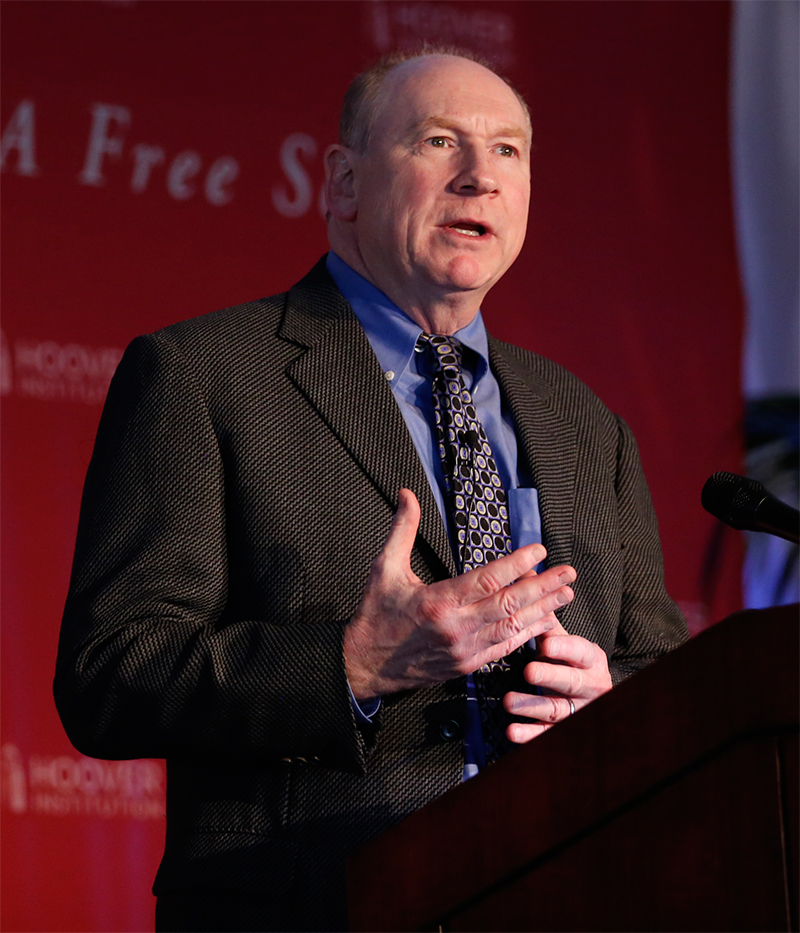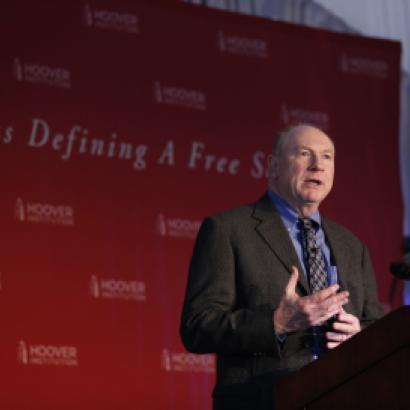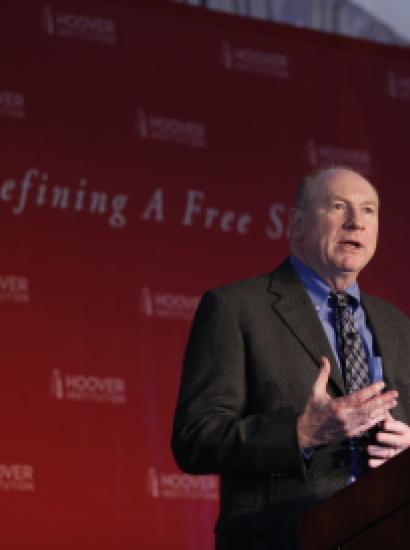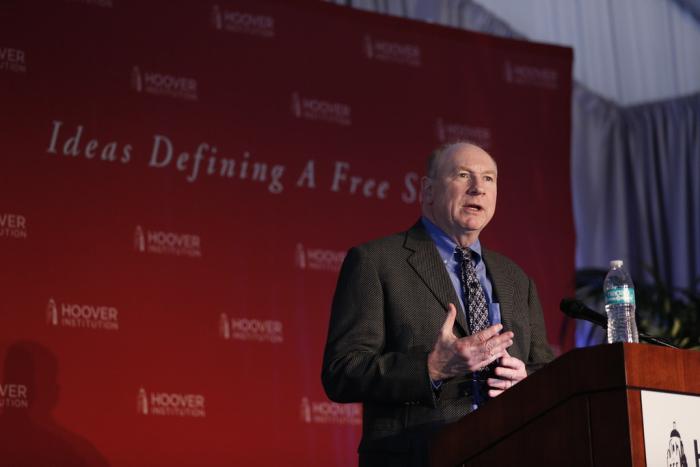
Once a beacon of opportunity, California’s economy is slowing and the state is mired in socially and politically fashionable policies, says Lee Ohanian, an economist at the Hoover Institution.
The wiser approach would be to adopt growth-supporting policies on taxes, energy, housing and public investment, said Ohanian, a Hoover senior fellow whose research focuses on economic crises, economic growth, and the impact of public policy on the economy.
“The recent history of California economic policies highlights just how important policies are for facilitating economic growth, producing high living standards, and creating economic opportunities for everyone,” he said.
For many years, California was the most rapidly growing state in the country, Ohanian pointed out. For example, California’s economy grew at a rate of 2.5 percent last year, falling short of the 3.3 percent year-over-year growth the Golden State saw in 2016.
“At the turn of the twentieth century, California was home to less than 2 percent of the population. By 1990, California accounted for 12 percent of the population. This remarkable growth was fostered by economic policies that were focused squarely on economic growth,” he said.
But California’s policy climate has changed over time, he said, as policies shifted from growth-supporting policies to ones much more focused on various social and political considerations.
“Consequently, our growth is much lower than in the past and economic inequality has increased to a record high,” he said.
Taxes, economy
Ohanian suggested the state of California could enact several reforms to spur growth and solve some of its economic and inequality ills.
“One very important area is tax policies. Currently, California has the highest tax rate for top earners across all states, which is 13.3 percent,” he said.
Factoring in other taxes, such as federal and local taxes, means that the most productive workers in California face an overall marginal tax rate approaching 50 percent, Ohanian noted.
“This is close to the level of tax rates in many Western European countries, such as France, Belgium, and Italy. This level of tax rates has been shown in several research studies to be a key factor in depressing Western European economies and is doing the same today in California,” he said.
Ohanian said that reducing tax rates is critical for expanding California's economic growth, particularly economic growth in the areas of California that remain depressed, such as the Central Valley.
Public investment
Another important policy reform is in the area of public investment, he said.
According to Ohanian, in the 1960s when California was growing very rapidly, state policy makers chose to invest as much as 20 percent of the state’s budget in capital projects, including new schools, transportation infrastructure, and water infrastructure, such as the massive California Water Project.
“It was widely understood by both Republican and Democratic elected officials that these investments were needed to support California’s substantial population and economic growth. Today, public investment is only about 2 percent of the budget, which explains why our roads, bridges, dams, and school buildings are now failing,” he said.
California’s current public investment budgets aren’t even sufficient to deal with depreciation, much less build new infrastructure, Ohanian stated.
“Restoring our capital spending budgets is necessary not only for increasing economic growth but also for improving public safety,” he added.
Business regulations
Business regulation is yet another area that merits reform, Ohanian said, noting that it’s important how a state like California is evaluated for its business climate compared to other states.
“These evaluations range from surveys of chief executive officers to academic studies that compare various factors affecting the cost of doing business within a state. Most of these assessments rank California near the bottom across states,” he said.
Ohanian said these studies indicate that improvements are needed in many areas affecting California’s business environment— for example, the state’s minimum wage, the state’s liability system, the state’s workman’s compensation system, and environmental regulations.
Housing costs, homelessness
Ohanian urges policy changes to reduce housing costs and homelessness.
“Out of control land use regulations and restrictions, such as zoning, are making it very hard to build new housing,” he said.
For many years, including the years of rapid population growth, the price of California housing was about 35 percent higher than the rest of the country, but was stable, Ohanian said.
“This means that the price of California housing was not rising any faster than in the rest of the country, despite so much population growth,” he added.
But in the 1980s when land use restrictions began to expand, the price of California housing began to climb relative to average prices in the rest of the country, Ohanian said.
“Now California housing prices are about 200 percent higher than the national average,” he noted. “To increase housing affordability, we need to make it easier and less expensive to build.”
In the current policy environment, California realistically will not build more housing unless it develops currently depressed areas, such as the Central Valley and other areas outside of coastal California, he said.
“This would offer the best chance to provide housing for many of the currently homeless,” Ohanian said.
In addition, a sizable fraction of the homeless are mentally ill and/or have drug or alcohol dependency problems. This will require treatment facilities, which again would be more cost-effective if they were built in lower cost inland areas, he added.
Ohanian said current approaches to treating homelessness are failing.
“Twenty-five percent of the homeless are in California. San Francisco is planning on spending up to $38,000 per year per drug addict, but there is no evidence that these problems are getting any better. In fact, current policy may be leading to more homelessness by making housing more expensive and by making drug use more accessible, as in San Francisco, which provides free hypodermic needles to addicts. Our housing cost problems and homelessness problems will not improve without a substantial change in policies,” he said.
Education, energy
Ohanian said California once had some of the best K–12 schools in the country. Yet today it ranks near the bottom of school rankings among the states.
Research by Hoover economists Rick Hanushek and Caroline Hoxby shows that reforms of teacher union rules would significantly improve California’s education outcomes, he said.
“This would include reforming teacher tenure rules,” said Ohanian, adding that Hanushek has shown that replacing the bottom 5–10 percent of teachers, with an average quality teacher could create up to $100 trillion in additional output and income.
“However, teacher tenure rules make it virtually impossible to fire a teacher for poor teaching performance. Teacher pay should also be based on their effectiveness, but teachers’ unions have consistently fought merit pay,” he said.
Ohanian said that Hoxby’s research shows that the lack of merit-based pay has directed many talented individuals away from teaching careers.
“This means that we have fewer ‘superstar’ teachers in our classrooms. The best teachers are incredibly valuable, and we should pay them well. In contrast, we now have tens of thousands of children whose education is being negatively affected by poorly performing teachers,” he said.
Ohanian said that research by Thomas Kane of Harvard shows that a student is actually better off not even attending school, rather than going to class with a poorly performing teacher.
“We need to improve the average quality of teachers and also reduce the number of very poorly performing teachers,” he said.
In terms of energy, California prides itself on leading the way with development of renewable energy, such as solar energy and wind power, said Ohanian, noting that California carbon emissions are down to 1990 levels, and its next goal is to reduce greenhouse gases 40 percent more by 2030.
“This certainly sounds laudable, but keep in mind that California is only responsible for about 2 percent of world greenhouse gas emissions. Thus, California can spend a lot of money in reducing carbon emissions, but it is just a drop in the world bucket and will make very little difference. Meanwhile, these energy policies are increasing California’s cost of living,” he said.
Beginning in 2020, California will require solar panels on almost all new houses, as well as the installation of expensive insulation, windows, and super energy-efficient appliances, according to Ohanian.
This may drive up the cost of California housing by more than $30,000, he estimated. “This is irresponsible in a state where only 30 percent of households can afford the median-priced house.”
Ironically, by raising the cost of housing, Californians are driving and commuting more than ever by living farther outside cities with high-paying jobs, such as San Francisco, and spending more energy doing so, Ohanian said.
“This is increasing the very emissions that the state is spending so much to reduce,” he added.
MEDIA CONTACTS:
Clifton B. Parker, Hoover Institution: 650-498-5204, cbparker@stanford.edu






















